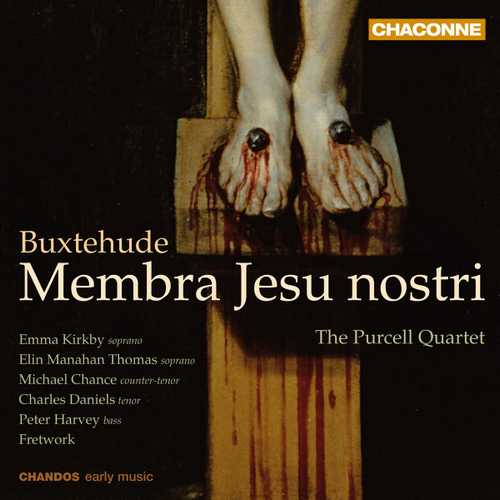

Composer: Dietrich Buxtehude, Matthias Weckmann
Performer: Purcell Quartet, Charles Daniels, Emma Kirkby, Michael Chance, Elin Manahan Thomas, Peter Harvey, Fretwork
Format: FLAC (tracks)
Label: Chandos
Catalogue: CHAN0775
Release: 2010
Size: 1.28 GB
Recovery: +3%
Scan: yes
Buxtehude: Membra Jesu nostri, BuxWV75
01. I. Ad pedes: Sonata
02. I. Ad pedes: Ecce super montes pedes
03. I. Ad pedes: Salve mundi salutare
04. I. Ad pedes: Ecce super montes pedes
05. I. Ad pedes: Salve mundi salutare
06. II. Ad genua: Sonata in tremulo
07. II. Ad genua: Ad ubera portabimini
08. II. Ad genua: Salve Jesu, rex sanctorum
09. II. Ad genua: Ad ubera portabimini
10. III. Ad manus: Sonata
11. III. Ad manus: Quid sunt plagae
12. III. Ad manus: Salve Jesu, pastor bone
13. III. Ad manus: Quid sunt plagae
14. IV. Ad latus: Sonata
15. IV. Ad latus: Surge, amica mea, speciosa mea
16. IV. Ad latus: Salve latus salvatoris
17. IV. Ad latus: Surge, amica mea, speciosa mea
18. V. Ad pectus: Sonata
19. V. Ad pectus: Sicut modo geniti infantes rationabiles
20. V. Ad pectus: Salve, salus mea, Deus
21. V. Ad pectus: Sicut modo geniti infantes rationabiles
22. VI. Ad cor: Sonata
23. VI. Ad cor: Vulnerasti cor meum
24. VI. Ad cor: Summi regis cor, aveto
25. VI. Ad cor: Vulnerasti cor meum
26. VII. Ad faciem: Sonata
27. VII. Ad faciem: Illustra faciem tuam
28. VII. Ad faciem: Salve, caput cruentatum
29. VII. Ad faciem: Amen
30. Buxtehude: Laudate pueri Dominum, BuxWV69
31. Weckmann: Kommet her zu mir alle
This new release from Chandos’ early music label, Chaconne, focuses on Buxtehude’s seven cantatas, collectively known as Membra Jesu nostri. These are among Buxtehude’s best-known works, and perfectly exemplify the seventeenth-century preference for musical structures that are broadly symmetrical, but subtly varied in detail. Each of the seven cantatas has roughly the same shape: Biblical passages are set for the whole ensemble and enclose stanzas from the mediaeval poem Rhythmica oratio, which are set as arias for reduced vocal forces and interspersed with instrumental ritornelli.
Buxtehude’s Membra Jesu nostri takes the form of a sequence of seven meditations on the crucified body of Jesus, beginning with the feet (‘Ad pedes’), followed by the knees (‘Ad genua’), the hands (‘Ad manus’), the side (‘Ad latus’), the breast (‘Ad pectus’), the heart (‘Ad cor’), and the face (‘Ad faciem’). As such, the work is written from the perspective of a penitent kneeling at the foot of the cross and gradually extending his gaze upwards, meditating on each part of the body in turn. The keys chosen for the cantatas seem to have added symbolic meaning. As the gaze rises, they move from flats to sharps, from C minor to E minor, before finally returning to the opening key to produce a beautifully unified cycle.
On this release the cantata cycle is complemented by Matthias Weckmann’s Kommet her zu mir alle, a setting of the words from St Matthew’s Gospel (11: 28 – 30), in which the composer gives the words of Jesus to a virtuoso bass singer with an impressive range of nearly two octaves, a part here performed by Peter Harvey, and provides him with an accompaniment of two violins, three bass viols, and continuo.
The works on this disc are performed by an excellent ensemble of early music specialists. As exclusive artists, The Purcell Quartet is today popularising the cantatas of Buxtehude in concerts and recordings involving a fabulous quartet of soloists – Emma Kirkby, Michael Chance, Charles Daniels, and Peter Harvey – to which, for the occasion, the group is joined by the soprano Elin Monahan Thomas. The Quartet has also recorded a huge range of music exclusively for Chandos, including works by Purcell, Corelli, Lawes, Bach, Handel, Vivaldi, Weckmann, Buxtehude, Leclair, Schütz, Couperin, and Biber, to outstanding critical and public acclaim. The early music specialists Fretwork, the viol ensemble, also performs on this recording.
Dietrich Buxtehude’s Membra Jesu Nostri, BuxWV 75 (“The Body Parts of Our Jesus”), can be sung by a choir and soloists, but the case for the one-voice-per-part performance heard here is unusually strong, and most of the available versions feature a “chorus” consisting merely of the four soloists together. It is not known for what occasion Buxtehude intended the music, but it has no liturgical use; it consists of a group of poetic meditations, with relevant biblical verses interpolated, on (in order) Christ’s feet, knees, hands, side, breast, heart, and face. This intrinsically philosophical concept seems intended for the contemplation of a small group of musicians and listeners. It also invites a kind of graphic emotion, which this group of English musicians largely avoids. Compare a bit of this recording with the more emotionally intense reading by Konrad Junghänel’s Cantus Cölln group to see which you prefer. The work’s modest dimensions flatter the voice of veteran soprano Emma Kirkby, but it is the rich countertenor of Michael Chance that stands out among the singers. An unusual feature of the performance is the mixed group of strings, with violins on top, from the Purcell Quartet, and old-style viols on the bottom from the ensemble Fretwork; the combination may or may not be historically justifiable, but the viols darken the sound in an attractive way and work well in the resonant acoustic of London’s St-Jude-on-the-Hill church. The booklet is superior, with full translations from Latin into English, German, and French. Not the only choice for this fascinating piece, but worth consideration for those favoring a soberer approach.